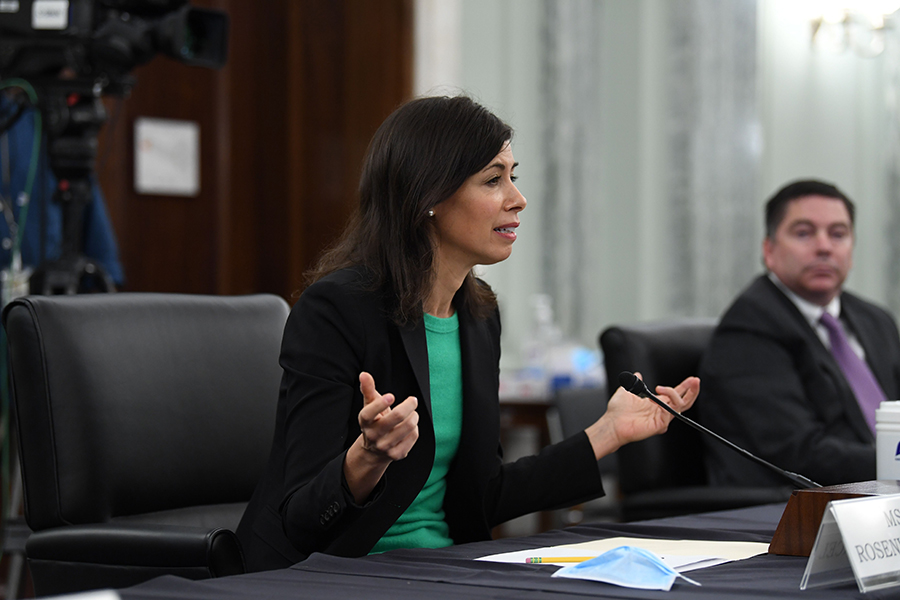Biden Expected to Make Narrowing Digital Divide an ‘Early, Urgent Priority’ to Help Students During Pandemic

Updated January 21
President Joe Biden named Jessica Rosenworcel — a strong proponent of eliminating the “homework gap” — as acting chair of the Federal Communications Commission. The senior Democrat on the commission, Rosenworcel has pushed for extending an internet discount program for schools to cover broadband service in students’ homes.
The education community has strongly supported her promotion because of her focus on addressing the inequities in at-home internet service for students — a position she espoused before the pandemic.
“Rosenworcel has long been a champion for closing the digital divide, advocating on behalf of the millions of students left behind because of inadequate internet access,” Anna Maria Chávez, executive director and CEO of the National School Boards Association, said in a statement.
With millions of students still lacking reliable internet to complete their assignments and interact with teachers, the incoming Biden administration is expected to take multiple steps to address the digital divide, according to sources who have participated in conversations with the transition team.
Bart Epstein, CEO of the nonprofit EdTech Evidence Exchange, said he understands naming a new director for the Office of Educational Technology to be “an early, urgent priority” for the administration.
Biden will also name an acting chair of the Federal Communications Commission, which oversees an internet discount program for schools. Many education advocates hope the future commission leader will favor a stronger federal role in ensuring that students have reliable at-home broadband service.
“I am hoping for strong leadership to be appointed to attack this once-in-a-generation problem,” said Epstein, whose nonprofit aims to help educators make smart decisions about online platforms and resources.
Epstein, who spoke with the transition team about the future of the office in a December meeting, described students falling further behind because they lack internet service or adequate materials as “a slow-motion, persistent catastrophe.”
The Biden approach would offer a sharp contrast to how the Office of Education Technology has operated during the Trump administration, particularly the 10 months of the pandemic. In keeping with her mission to reduce the department’s footprint, former Education Secretary Betsy Devos downsized the office by at least half, and its current director, just hired last June, is a cybersecurity expert, not an educator. State and local-level education leaders said the office could have provided far greater guidance to first-time remote teachers looking for tools and materials. And with widespread virtual learning expected to continue beyond the pandemic, some are hoping for what Epstein called an “Apollo-type mission” to improve K-12 distance learning.
When schools closed in mid-March, “I don’t think for a second any superintendent thought there would be direction from the education secretary or the Office of Educational Technology — and we were right,” said Matt Miller, superintendent of the Lakota Local Schools, north of Cincinnati, Ohio. By the time the office issued the first of three “digital learning guides” in October, he said, “we were past that.” Two additional guides were released just last week.
The department did not respond to a request for a comment.
The office could be helping states determine the best way to use relief funds for digital learning, said Joseph South, past director of the office during the Obama administration and now chief learning officer at the nonprofit International Society for Technology in Education. He added that currently, “the implementation of ed tech practices across the country is all over the place — from completely dismal to astonishingly good.”
Doug Casey, incoming chair of the State Educational Technology Directors Association, stressed that like states and districts, the education department was caught off-guard by the pandemic and tried to minimize “a chaotic set of circumstances for students, families, teachers and leaders.” But he acknowledged that the Trump administration “appeared not to have placed digital learning best practices and resources on the top of its list.”
‘A game changer’
Looking ahead, educators hope to see less chaos and more collaboration across federal agencies to address the remaining gaps in broadband access. Senate Democrats have proposed using the FCC’s E-Rate program to eliminate the “homework gap,” by extending the telecommunications discount for schools and libraries to cover broadband access in students’ homes. Outgoing FCC Chairman Ajit Pai, a Republican, has maintained that the Communications Act prohibits that option.
A report issued last summer estimated that 17 million U.S. students lack the internet service they need to fully participate in online learning. And according to a recent University of California, Los Angeles, analysis, the lack of a device or reliable internet is linked to fewer virtual contacts with teachers and less time spent on learning.
One of the most outspoken advocates for changing the rules, however, is Jessica Rosenworcel, the senior Democrat on the commission and a leading candidate to replace Pai as chair. Rosenworcel, who has received endorsements for the post from the National Education Association and a communications union, has argued Congress should “modernize” E-Rate to subsidize home internet access and supplement funding for devices.
The agency “cannot forget the millions of students caught in the homework gap because they lack high-speed service at home and are locked out of the virtual classroom,” she said at the FCC’s monthly meeting last week.
The UCLA report showed that a third of households have limited digital access, with low-income families especially likely to lack devices or an internet connection.
“E-Rate could be a game changer in this equation,” South said. “Because E-Rate is an existing program, it would be one of the fastest, most reliable ways to solve this pressing need.”
Kristina Ishmael, a digital learning expert who served on the Biden-Harris transition team, said a partnership between the FCC and the education department could lead to new guidance on eligible E-Rate expenses. One sought-after fix would allow internet providers to invoice districts for service to students’ homes instead of expecting families to submit paperwork for reimbursements.
Rosenworcel is one of two Democrats on the commission, along with two Trump appointees. President-elect Biden will name an additional appointee to fill the gap left by Pai. South added that if Rosenworcel becomes chair, he would expect “rapid action” regarding the homework gap and “high engagement with Congress to hammer out a sustainable solution.”

‘Those last few miles’
In many rural areas of the country, however, the problem isn’t unreliable internet access — it’s no access.
“Big companies have not been willing to pay what it costs to do those last few miles to get to the homes,” said Barbara Nemko, superintendent of the Napa County Office of Education in California, which includes five districts. One is completely remote and the others have a hybrid schedule.
Many teachers in the county are still giving students paper packets or having them download materials while at school so they can work on them at home, Nemko said.
To address those gaps, it will take more than changing E-Rate. In February, Biden is expected to announce the second phase of his recovery plan, which will focus on infrastructure. Nicol Turner Lee, a senior fellow at the Brookings Institution, is calling for a “Tech New Deal” that includes a “No Child Offline” plan and incentives to expand broadband in “un- and under-served areas.”
The $900 billion relief bill Congress passed in December included a $3.2 billion temporary Emergency Broadband Benefit Program, especially targeted to families with school-age children. The benefit provides up to $50 per month for low-income households and up to $75 per month for families living on tribal land. An earlier version of the relief bill included $3 billion specifically in E-Rate funding, but that provision was dropped in final negotiations.
States are also receiving $54 billion — three times the amount they did under the March relief package — and the education department is expected to judge districts on how they use some of those funds to address learning loss.
Education Secretary-designate Miguel Cardona, who prioritized getting devices and internet service to all students in Connecticut in his role as state commissioner, is expected to continue that push at the federal level. In December, Connecticut Gov. Ned Lamont said the state was the first in the nation to reach that milestone.
“I have seen firsthand [Cardona’s] passion to ensure equal opportunity for all students,” said Casey, who also directs the Connecticut Commission for Educational Technology.
Calling for a ‘well-resourced’ office
Regarding the previous secretary, Casey said that while his state-level colleagues didn’t expect the technology office to provide all the answers regarding distance learning, “staffing levels do reflect priorities.”
Under secretaries Arne Duncan and John King — and former technology directors South and Richard Culatta — the office typically had 14 to 15 people, said Ishmael, a former fellow in the office and now director of primary and secondary education at Open Education Global, a network focusing on free educational materials. Miller, in the Lakota district, added that through various technology initiatives, districts and school networks frequently interacted with the department.
“I knew Arne Duncan. I knew John King. I knew Richard Culatta. I knew Joseph South,” he said. “I don’t know anybody anymore.”
Nemko added, however, that DeVos’s predecessors also share some of the blame for the department’s lack of preparation for the pandemic. “They were there for eight years,” she said. “This is not a new problem we discovered yesterday.”
Currently, the technology office has two political appointees and three career staff members. A series of acting directors filled in until Adam Safir was appointed last June. Since the onset of the pandemic, in addition to the three guides, the office published some blog posts and held a virtual summit on tribal broadband access. DeVos also distributed more than $180 million in “microgrants” from the March relief package to 11 states, with an emphasis on remote learning.
Still, South described the lack of leadership as “a devastating oversight and lost opportunity” and said the office could have helped publicize the best of what states and districts were developing to support virtual learning.
The federal government has an additional role in conducting research, said Epstein. “I am hopeful the new administration will recognize that educational technology has exploded in volume, potential and use, and it needs to be studied,” he said.
The term “moonshot,” he said, is overused. So he chose a different analogy to emphasize the need for an ongoing commitment instead of a one-time initiative.
“One of the biggest challenges is what I would call the need for an Apollo-type mission, because it drove a decade of science and technology,” he said. “We need that now.”
Get stories like these delivered straight to your inbox. Sign up for The 74 Newsletter

;)
